By 2016 POP Intern, Bridget Downey, and POP Program Director, Robyn Mello
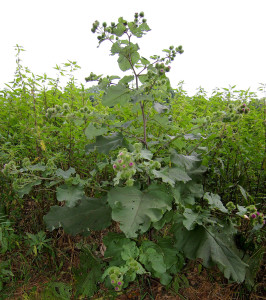
Burdock is one of the first plants to be aware of at the start of spring when plants begin to emerge. Though it’s mostly loathed by gardeners, landscapers, and pet-owners due to its opportunistic nature and tenacious seedheads, it’s also a weed that is worthy of respect. Its strength performs essential work for both damaged ecosystems and damaged body systems. Unless you’re bagging the seed heads for deliberate seedsaving and future planting, YOU DO NOT WANT THIS PLANT TO SET SEED, but take a few minutes to learn about it before you respectfully remove it from your orchard space–in the event it may change your relationship to the plant!
Burdock is a non-native species that came across the Atlantic from Europe. Livestock shipped from Europe with seed pods stuck in their fur spread seed once they arrived on American soil. It was widespread in Pennsylvania by the 1800s, and the plant has since ended up everywhere but areas along the Mexican border and the Great Lakes.
For many, burdock is an unwanted weed that takes up much of our time, energy, and space. Just as POP and other urban agriculturists look at vacant lots in the city and see a dazzling opportunity for growing, so does burdock. Burdock’s prickly seed pods will stick to clothes, shoes, hair, fur, gloves (just about anything!) and spread everywhere you go. It’s quite literally nature’s Velcro and the inspiration which led to Velcro’s invention in 1941.
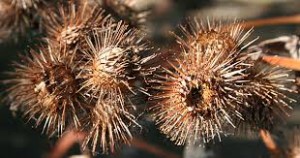
A battle between gardener and weed is not ideal, especially since plants often have the upper hand. While humans only tend and visit their growing spaces, plants live permanently in their space, consistently photosynthesizing, growing, and reproducing. So how do we make burdock work for us as we work to rid it from our spaces?
Ecological indications
It may be surprising, but burdock actually has several positive qualities. Along with dandelion, burdock is often one of the first plants to pop up and cover disturbed sites and bare landscapes, working to prevent erosion, restore soil health, and shade the earth with its elephant-ear leaves. It can send its sturdy taproot two feet deep into the soil, making it very difficult to remove but great for breaking up compacted earth. It opens up air and drainage pathways to make way for other roots, water, and soil life, and it assists in nutrient accumulation closer to the surface. Gardeners with The University of Massachusetts Permaculture and Dining Hall Gardens intentionally plant burdock for the strength of its root! It reportedly accumulates copper, which assists in the prevention of mildew, a major problem for fruit and vegetable growers. [NOTE: Burdock leaves are also known to be afflicted by powdery mildew, so this may only be slightly useful.]
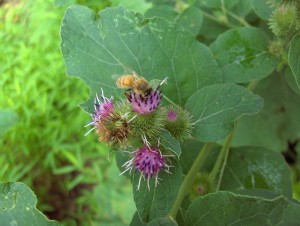
Burdock is also a valuable forage for pollinators and a shelter for beneficial insects, providing nectar and pollen during the time just prior to goldenrod flowering in late summer and early fall. If your space doesn’t have flowering plants that fill this time period, consider leaving burdock to flower to assist pollinators, and then diligently remove its flower stalks before they’re able to set seed.
Human health benefits
NOTE: The following information has not been evaluated by the Food and Drug Administration. Please read our full edible/medicinal use disclaimer at the end of this article and seek medical advice from a qualified professional before using a new plant in your diet. POP and its affiliates are not replacements for your medical provider.
Do you have a site that’s full of burdock and has had soil test results free of major contamination problems? There may be herbalists and foragers in the Philadelphia area that are interested in helping rid you of your weeds to make food and medicine! Burdock’s nutrient accumulation also makes it a nutrient dense vegetable and ancient herbal medicine, and it’s prized as a food and herb in many cultures. In Japan, burdock is called gobo. Its roots are eaten like carrots and young shoots are consumed like artichoke and rhubarb. It is commonly added to sushi, soup, stir-fry, and cooked with other roots like ginger, garlic, and carrot. Fresh or dried, the root can also be decocted as a tea or made into a tincture. Here are 347 burdock recipes from which to experiment!
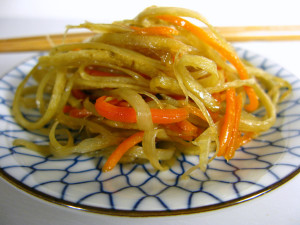
Medical herbalists and holistic medicine practitioners have been using burdock for generations. As such, they consider burdock a bitter. Additionally, it is believed that burdock aids in digestion, supports the liver, promotes healthy kidney function, cleanses the blood, nourishes the skin, is very high in iron, and acts as a detoxifying tonic for the whole metabolic system. The roots are nearly 40 percent inulin, a complex sugar/starch which acts as a nutritive, nourishing the body by feeding our beneficial gut microbiota and assisting in keeping insulin levels balanced. This is a very good plant for diabetics and pre-diabetics. As it aids our digestion, this plant also works from the inside out to treat skin conditions such as acne and eczema. In combination with sassafras, it may soothe the hypothalamus, aiding the pituitary gland do adjust hormones and body weight.
Living in an urban environment means exposure to plenty of pollutants and potentially heavy metal contamination. While burdock root may pick up heavy metals from contaminated soils, others agree it may also a potent detoxifier of heavy metals in human bodies.
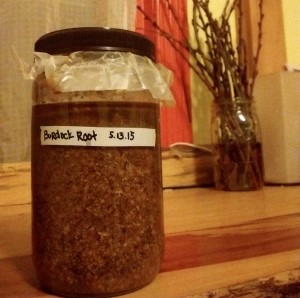
Proper Harvest and Removal
Burdock is a biennial plant, meaning it has a two year growing cycle. In the first year, leaves and a rosette are formed. In the second year, it flowers, goes to seed, and then dies. If you’re harvesting root for food, many sources say it’s best to harvest in fall of the plant’s first year after the leaves have died back and its energy has been set as sugar in the root. However, the very beginning of spring in the plant’s second year is probably also a great time because it hasn’t yet expended that energy. To get rid of this plant, we have to focus on its main way of spreading itself, through the burrs. If you enter or maintain a site where you find burrs, find some way to easily collect and remove as many as possible prior to sprouting (perhaps an old mop head dragged along the ground after removing plant parts and picking up the largest burr clusters). Do not compost them. It’s not worth the trouble if your compost pile doesn’t get hot enough.
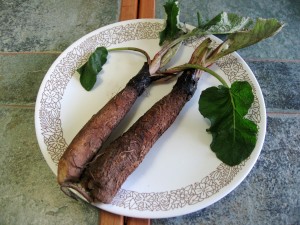
It’s also very important to note that these plants may be able to resprout from their roots if large enough chunks of them are left in the ground. A very trustworthy Philly gardener said, “In my experience, if the shovel chops through the root several inches down, it does not resprout. I think Burdock has a cluster of buds near the root crown, not sure how far down, but all fairly close to the surface (maybe the top inch or so), and that it can’t resprout below those buds.” To be safe, if you enter or maintain a site where you find older first-year plants or established second-year plants, wait until after a good rain or water the area to first loosen the soil, and then use a spade shovel to dig down deeply and remove as much of the root as possible. If you’re not going to use it for food or medicine, feel free to compost your burdock root, but do not turn/till it back into the ground before it decomposes. This way, the nutrients will reenter your soil but you won’t be in danger of plants resprouting.
The most important part of eradicating burdock comes with the second year plants. Remove all flowering heads from the plants so they have no way of going to seed. If you do not want to disturb the earth by turning in the soil, burdock can be managed by cutting and removing all flowering tops. This low-impact method requires much more vigilance, however, and can take a few years until the plant exhausts its energy and the seed bank has diminished.
If your site is so overrun with burdock that none of the above methods are sufficient, very thick sheetmulching with landscaping fabric, several layers of cardboard, and woodchips may suffice, but disturbing the soil after sheetmulching breaks down may bring the old seedbed to the surface.
Another method of maintenance is through improving soil health and nutrient balance. In When Weeds Talk, Jay L. McCaman says burdock grows in soils with very high levels of iron and sulfate (sulfur) and very low levels of calcium and manganese. “When you balance the soil, you may lose the weed.”
Burdock is fantastic, but it can be a great burr-den if you fail to be vigilant in your orchard space. Get rid of the flowers before they go to seed so they are unable to spread. Listen to your land. Whether you want to grow it to break up and restore the soil, as a nourishing dinner, or you are simply trying to get rid of the weeds, we wish you the best of luck!
SUPPORT US! If you found this entry useful, informative, or inspiring, please consider a donation of any size to help POP in planting and supporting community orchards in Philadelphia: phillyorchards.org/donate.
Sources
http://www.skillsforwildlives.com/2010/06/burdock-root-when-should-i-harvest/
http://extension.psu.edu/pests/weeds/weed-id/common-burdock
http://www.acresusa.com/weeds-and-why-they-grow
http://horticulturecenter.illinoisstate.edu/gardens/documents/weeds_000.pdf
http://fyi.uwex.edu/weedsci/1997/11/02/common-burdock/
https://www.wikiwand.com/en/Arctium
http://fyi.uwex.edu/weedsci/1997/11/02/common-burdock/
http://www.motherearthliving.com/health-and-wellness/burdock-does-it-all.aspx
https://druidgarden.wordpress.com/tag/burdock/
http://ontariowildflowers.com/mondaygarden/article.php?id=166
http://goodoak.com/info/weeds/burdock.pdf
http://www.naturalnews.com/026885_natural_zeolite_heavy_metals.html#
EDIBLE/MEDICINAL USE DISCLAIMER:
The Philadelphia Orchard Project stresses that you should not consume parts of any wild edible plants, herbs, weeds, trees, or bushes until you have verified with your health professional that they are safe for you. As with any new foods that you wish to try, it is best to introduce them slowly into your diet in small amounts. The information presented on this website is for informational, reference, and educational purposes only and should not be interpreted as a substitute for diagnosis and treatment by a health care professional. Always consult a health care professional or medical doctor when suffering from any health ailment, disease, illness, or injury, or before attempting any traditional or folk remedies. Keep all plants away from children. As with any natural product, they can be toxic if misused. To the best of our knowledge, the information contained herein is accurate and we have endeavored to provide sources for any borrowed material. Any testimonials on this web site are based on individual results and do not constitute a warranty of safety or guarantee that you will achieve the same results. Neither the Philadelphia Orchard Project nor its employees, interns, volunteers, or website contributors may be held liable or responsible for any allergy, illness, or injurious effect that any person or animal may suffer as a result of reliance on the information contained on this website nor as a result of the ingestion or use of any of the plants mentioned herein.